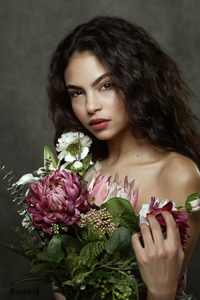
Creating a studio portrait is an art that requires talent, technique, and a good connection with the subject. As a professional photographer based in Geneva, I will share with you some secrets and tips for succeeding in your studio portraits, creating a warm atmosphere, and capturing the unique personality of each subject.
Preparation
The first step to succeeding in a studio portrait is good preparation. Before the photoshoot, take the time to discuss with the subject to understand their expectations and preferences. This will allow you to adapt to their style and create an ambiance that suits them.
Lighting
Lighting is crucial for a successful portrait. Use soft and diffused light sources, such as softboxes or reflector umbrellas, to avoid harsh shadows and unwanted reflections. Don’t hesitate to experiment with different lighting positions and intensities to find the best look that enhances your subject.
Model direction: Incorporating movement and self-connection
Allow your model to express themselves freely throughout the session, encouraging them to adopt poses that resonate with them. It’s important to consider the model as an active participant in the creative process.
If you notice that the poses are too stiff, it can be interesting to suggest incorporating movement. For example, ask them to turn towards the camera after a countdown or simply run their hand through their hair to fix it. These natural actions can help relax the model and create more dynamic and authentic shots.
It can also be beneficial to suggest that the model deliberately closes their eyes for a few shots. This technique not only helps them reconnect with themselves and internalize the session but also creates visual intrigue that prompts viewers to imagine what the model might be thinking. Furthermore, when the eyes are reopened, the model may feel more relaxed and in tune with the present moment, resulting in more natural and authentic photos.
However, don’t hesitate to give clear and precise instructions when necessary while still encouraging the model to be themselves and relax in front of the camera. Patience and communication are key to capturing the best shots possible and creating a memorable experience for both the model and the photographer.
Background
Choose a neutral and solid background to avoid distracting attention from the subject. Fabric backgrounds, such as cotton or muslin, are ideal for absorbing light and creating a soft and warm atmosphere. You can also opt for paper backgrounds available in different colors and textures.
Composition
Composition is a key element in capturing the subject’s personality. Experiment with different angles, perspectives, and framing to find the one that best highlights the model. Consider the rule of thirds to create a balanced and harmonious image.
Focus
Make sure the focus is on the subject’s eyes as they attract attention and convey emotion. Use a moderate aperture (f/5.6 – f/8) to achieve sufficient depth of field and keep the facial details sharp.
Post-production
Photo retouching is a valuable tool for enhancing your studio portraits. Use retouching software to adjust light levels, contrasts, saturation, and to eliminate any imperfections. However, be careful not to over-retouch the image to maintain the authenticity and personality of the subject.
In conclusion
The success of a studio portrait relies on good preparation, mastery of lighting, model direction, composition, and post-production. By applying these tips and tricks, you can create a warm atmosphere and capture the unique personality of each subject. Remember to foster collaboration with your model and consider them as a key actor in the creative process. This way, you will achieve authentic and memorable studio portraits.